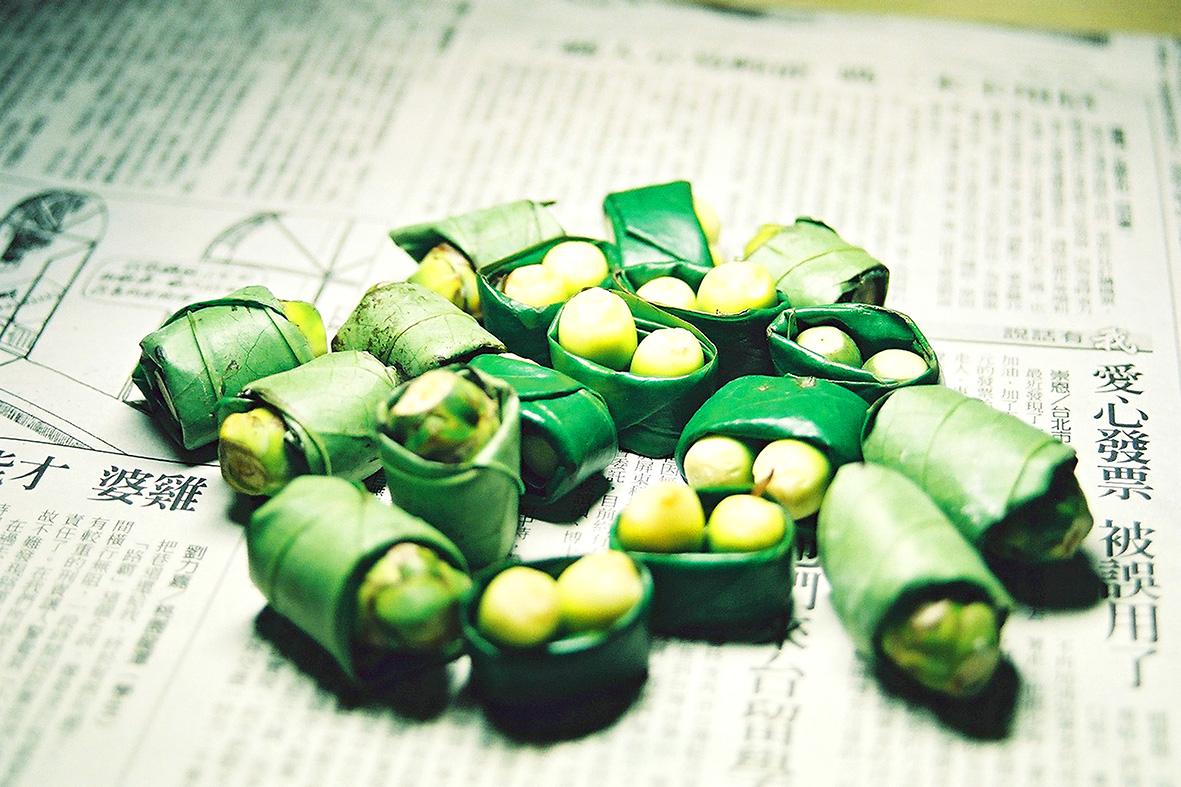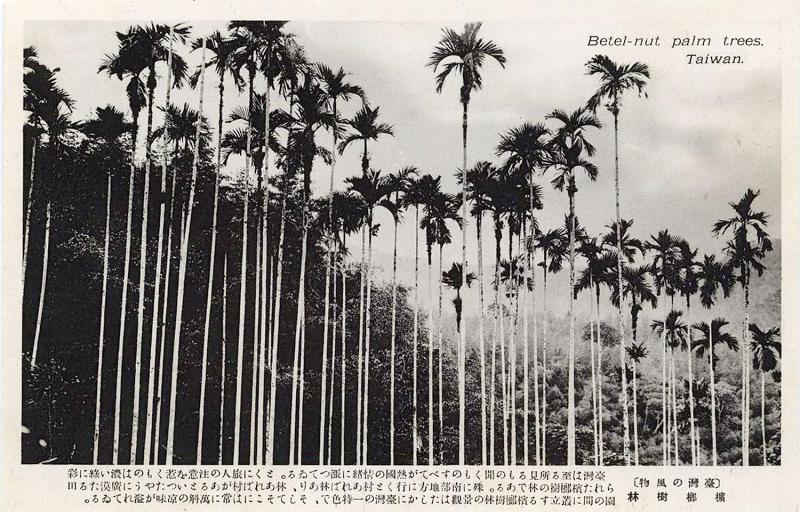Dec. 7 to Dec. 13
Those in the betel nut industry hated Hahn Liang-jiunn (韓良俊). In June 1997, about 20,000 farmers and vendors gathered outside the Legislative Yuan, where Hahn was giving a presentation during a public hearing to discuss the relationship between chewing betel nut and oral cancer.
Amidst loud boos from the crowd, a burly man entered the chamber and walked up to the podium, gave Hahn a nasty glare and snatched his microphone before a legislative assistant stopped him. Hahn snuck out the back door after finishing his speech, but the mob then headed to National Taiwan University Hospital, where Hahn worked as an oral and facial surgeon, screaming his name and asking him to come out and face them.

Photo courtesy of Wikimedia Commons
The backlash was expected. The mildly narcotic nut, usually taken with a brick-red or milky-white mix of ash and leaf, were dubbed “green gold” (綠金) and “green jewels” (綠寶石) in the 1980s as the industry boomed, and served as essential item in all sorts of social occasions. Hahn once penned an ad in the Liberty Times (the Taipei Times’ sister newspaper) requesting mayoral candidates to avoid handing out betel nuts when campaigning for office. Another problem was that significant plots of land were being cleared to plant betel nut trees, leading to landslides during heavy rains.
Despite the numerous threats, Hahn continued his crusade against chewing betel nut, and the government designated Dec. 3, 1997 as the nation’s first Betel Nut Prevention Day. Hahn chose the date from the statistic that people who smoke cigarettes, drink alcohol and chew betel nut is 123 times more likely to develop oral cancer.
On the 20th Betel Nut Prevention Day in 2017, Minister of Health and Welfare Chen Shih-chung (陳時中) announced that betel nut chewing among the population had dropped from 17.2 percent to 8.4 percent during this time. This old habit still endures, but the government hopes to cut it to below 4 percent in the near future.

Photo courtesy of Health Promotion Administration
LONGTIME HABIT
Archaeological evidence shows that Taiwan’s inhabitants have been chewing betel nut for 4,000 to 5,000 years. It was used for medicinal, social and ritualistic purposes and still is an essential item in Aboriginal culture.

Photo courtesy of Lafayette College Libraries via Open Museum
Lin Fu-shih (林富士) writes in a paper, “Betel Chewing: An Examination of the Factors that Affect Food Safety” (試論影響食品安全文化因素:以咀嚼檳榔為例) that scholars aren’t clear if Han people practiced the habit while they were still in China, or they picked it up after coming in contact with Aborigines in Taiwan.
Qing Dynasty officials and scholars visiting Taiwan wrote frequently about betel nut in the 1600s and 1700s, and a 1717 official record states that they were used to “ward off pestilence, entertain guests and resolve conflicts,” and were enjoyed by men and women alike. Even monks took up the habit, to the government’s dismay.
A 1763 record adds that people chewed betel nut as soon as they woke up and that their “mouths were never empty.” No matter how poor the family was, they would rather spend money on the habit than on food. Several reports noted the harmful health effects of the habit, with a 1832 text mentions “blackened teeth and depletion of qi (氣),” or vital life forces.
During the Japanese colonial era, officials and the Taiwanese elite frowned on the practice. The government fined people who spit betel nut juice on the street and encouraged farmers to grow other crops, but the influence was minimal, Lin writes. The opposition to betel nuts grew stronger during the kominka period, when the Japanese sought to assimilate the Taiwanese. One news report from 1937 described how Aboriginal youths from Pingtung swore off the habit and were planning on banning it in the community.
But the farming resumed and intensified after the Chinese Nationalist Party (KMT) takeover in 1945, and the habit spread from mostly Aboriginals and laborers to middle class businesspeople. The industry reached its peak in the 1980s as Taiwan’s standard of living improved, when the product was dubbed “Taiwan’s chewing gum.”
SAYING NO
By 1996, 57,000 hectares were devoted to betel nut cultivation, and Hahn estimated that there were up to 3 million users with the number continuing to rise.
Hahn returned to Taiwan in 1972 after completing his medical studies in Japan. During his first decade practicing at National Taiwan University Hospital, he noticed an increasing number of patients with oral cancer or exhibiting pre-cancerous symptoms. Most of them were men in their 50s, and few of them lived long after being diagnosed.
After investigating, he found that 90 percent of these patients were habitual betel nut chewers. He appeared on television to warn people of the risk, and also devised a method to quickly detect signs of oral cancer in patients.
His writings and promotional material published with cancer prevention foundations grabbed the attention of the public and government in 1993, and in 1994, the Executive Yuan’s Board of Science and Technology called for the formation of a cross-department betel nut prevention task force. The following year the Department of Health (today’s Ministry of Health and Welfare) began working on the issue.
Of course, star power is needed for such campaigns, and in 1996 movie star Chen Sung-yung (陳松勇) became the government’s first anti-betel nut spokesperson. The words “green bomb, red terror and white suffering,” flashed across the television screen while red juice spattered against images of flashy nightclubs and a sickly man in a wheelchair. Chen makes his plea in Hoklo (commonly known as Taiwanese) and Hahn appears at the end to provide the harrowing statistics.
Politicians in the betel nut counties of Pingtung and Nantou immediately fired back, and the debate was on. Even business tycoon Wang Yung-ching (王永慶) chimed in, penning several editorials in the Liberty Times lambasting the habit. But it wasn’t until 2003 that Hahn’s beliefs were officially validated when the International Agency for Research on Cancer found that betel nut is carcinogenic.
Now 84, Hahn continues to focus attention on the dangers of chewing betel nut, last year urging the government to end its longtime passive “three no” policy toward betel nut: no prohibition, no encouragement and no assistance.
“Those three ‘nos’ added together equals no responsibility!” he said.
Taiwan in Time, a column about Taiwan’s history that is published every Sunday, spotlights important or interesting events around the nation that either have anniversaries this week or are tied to current events.

The depressing numbers continue to pile up, like casualty lists after a lost battle. This week, after the government announced the 19th straight month of population decline, the Ministry of the Interior said that Taiwan is expected to lose 6.67 million workers in two waves of retirement over the next 15 years. According to the Ministry of Labor (MOL), Taiwan has a workforce of 11.6 million (as of July). The over-15 population was 20.244 million last year. EARLY RETIREMENT Early retirement is going to make these waves a tsunami. According to the Directorate General of Budget Accounting and Statistics (DGBAS), the

Many will be surprised to discover that the electoral voting numbers in recent elections do not entirely line up with what the actual voting results show. Swing voters decide elections, but in recent elections, the results offer a different and surprisingly consistent message. And there is one overarching theme: a very democratic preference for balance. SOME CAVEATS Putting a number on the number of swing voters is surprisingly slippery. Because swing voters favor different parties depending on the type of election, it is hard to separate die-hard voters leaning towards one party or the other. Complicating matters is that some voters are

Five years ago, on the verge of the first COVID lockdown, I wrote an article asking what seemed to be an extremely niche question: why do some people invert their controls when playing 3D games? A majority of players push down on the controller to make their onscreen character look down, and up to make them look up. But there is a sizable minority who do the opposite, controlling their avatars like a pilot controls a plane, pulling back to go up. For most modern games, this requires going into the settings and reconfiguring the default controls. Why do they

Take one very large shark, a boat (we’re gonna need a bigger one of those) and a movie that ran way over budget and you’ve got all the ingredients of a career-making film for one of Hollywood’s most successful directors. Now fans of Jaws — Steven Spielberg’s terrifying thriller about a man-eating shark — can re-live the movie as it celebrates its 50th anniversary in an exhibition at the Academy Museum in Los Angeles. “The film certainly cost me a pound of flesh, but gave me a ton of career,” Spielberg told reporters as he toured exhibits of props and memorabilia